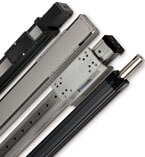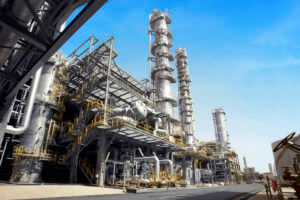
Better welds with electric linear actuators for resistance welding robots
U.S. and European car manufacturers have long been convinced of the benefits of automation in their production facilities. Spot welding robots are common in their body production lines.
Automation and robotics offer advantages in cost savings and quality, but plants in India, China, and Southeast Asia have been slow to get on the bandwagon. Perhaps some plant managers see these production processes as too expensive or difficult to implement. Whatever the reason, that situation may be changing according to a Frost & Sullivan study described in an article on The Fabricator.com

Compact, integrated linear actuator helps the show go on
Ever have an application where you had space for a pneumatic cylinder but needed the precision, programmability, and low maintenance of an electric linear actuator? You needed a compact, precise, reliable linear actuator. Does such a product exist? Of course it does! Here's a case study about an application where an integrated actuator solved this problem.

About the pneumatic linear actuator
Who doesn’t love a classic? There are classic clothes - like t-shirts and pull-over sweaters. Classic building designs - like Greek Revival and Victorian. Even classic cars. Whether it’s a building, a car or a pair of jeans, there’s nothing like the time-tested design and reliability of a classic.
When it comes to industrial automation, the pneumatic linear actuator or pneumatic air cylinder is a leading example of time-tested reliability. Since 1955, we've been developing and manufacturing these dependable workhorses for industry

Electrical noise and linear actuators
Electrical noise is a common occurrence. Random fluctuations in electrical signals are known as noise, and if the amplitude of the fluctuations becomes high enough, the noise can interfere dramatically with the operation of industrial automation devices like linear actuators. The results can be anything from erratic movements to complete system failure.

Linear actuator reduces energy use in food & beverage processing
Once upon a time, managers of food and beverage processing plants considered energy costs to be a basic cost of doing business – something out of their control. But several factors have changed that attitude. Among them are rising energy prices, a challenging economy and an emphasis on reducing the environmental impact of manufacturing facilities.
Processors now see energy use as a cost that can and should be strategically managed. Companies are trying to optimize their energy budgets – increasing their plants’ energy efficiency, reducing use and looking for lower cost, cleaner energy sources. They're also looking at the energy use of all machinery and automation components like linear actuators.

What you need to know about electric linear actuators
Electric or pneumatic? That is the question. Or at least it’s a crucial question that control systems and machine design engineers ask early in the process of specifying a linear actuator. A pneumatic cylinder may be the best solution -- easy-to-understand, lower cost -- but then again an electric linear actuator can offer distinct advantages. It really depends on the application.

Brushless servo motors – more control for valves with linear actuators
Process industry engineers are looking to more sophisticated motion control solutions for valve automation because of an ever-growing need to improve productivity, increase efficiency, and minimize downtime.
These engineers must control the valves that regulate the flow of materials throughout a facility, and there are two basic ways to control these valves: linear motion (rising stem) and rotary motion (half turn or quarter turn). Powered rising stem valves are often used in mission-critical areas of a process. In these applications, reliability, repeatability, accuracy, and responsiveness are crucially important. These factors impact the type of valve actuation specified. There are traditional methods: pneumatic or hydraulic actuated systems and electric linear actuators driven by brush servo motors. Then there’s an emerging technology: brushless servo motor driven electric valve actuators.

Something completely different – unique electric linear actuator applications
We all recognize that linear actuators are critical and much-used components in industrial automation systems. They’re at the heart of many machine tools, conveying configurations, and packaging systems. But what if we look beyond those industrial uses? Here are a few unique applications our actuators have found themselves in.

Mechatronics, electric linear actuators and control system design
If you’ve been around engineering, you’ve probably heard the term “mechatronics” used to refer to a design process that blends mechanical engineering, electrical engineering, telecommunications engineering, control engineering, and computer engineering. Mechatronics is a multidisciplinary approach that rejects splitting engineering into rigidly separate fields. Originally, mechatronics just included mechanics and electronics; however, as technical systems have become more complex the word has been broadened to include more technical areas.

How electric linear actuators improve automation results
The industrial revolution continues to rock the world as improvements in factory automation create ongoing change. The goal of saving money while improving quality is at the core of the drive towards more sophisticated automation. Savings come from reduced labor costs, higher throughput, lower energy use, or reduced waste. Better quality is a by-product of controlling variables within tight tolerances.

 Ask an Engineer
Ask an Engineer